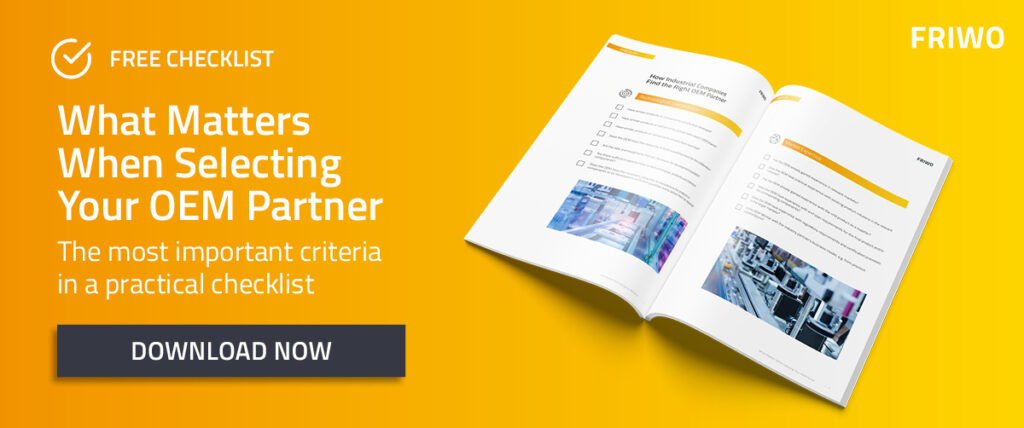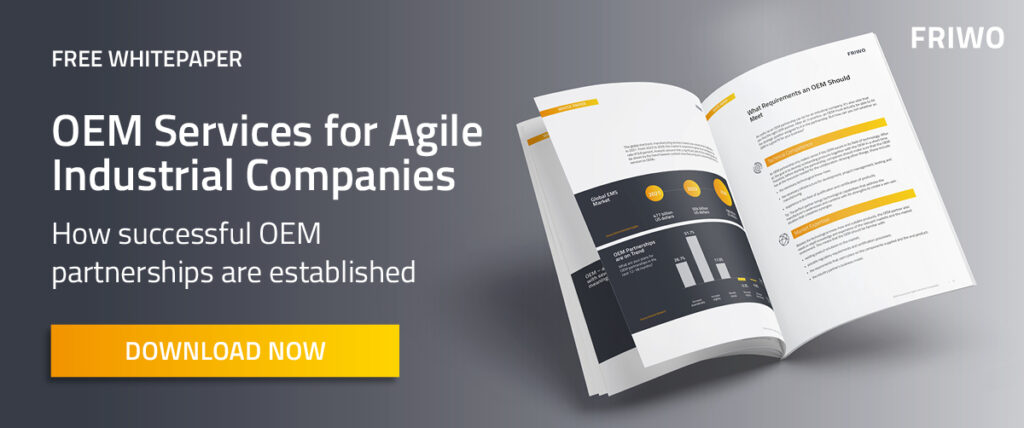5 Criteria That Companies Should Consider When Selecting an OEM Partner

In this form of cooperation, the partner company contributes suitable components and modules to the industrial company’s systems as an original equipment manufacturer (OEM). The collaboration can range from the development phase right through to the production phase.
For this partnership model to generate tangible added value, the OEM partner must be integrated very deeply into the value chain. For example, by transferring the entire range of development and production of complex components – such as a drive unit or power supply – to the OEM partner.
This form of cooperation gives industrial companies a competitive edge in several respects: time-to-market improves and product quality increases, while costs are significantly lower than if the OEM’s services were provided in-house. However, this calculation only works if the OEM partner is a good match for the industrial company.
For the OEM partner to be a real hit, however, it should not be assessed in the same way as an ordinary supplier. Rather, the special requirements that an OEM has to meet because of its high strategic importance must be taken into account. This blog post gives you an overview of the specific criteria you should consider as an industrial company when selecting the right OEM partner.
First Requirement: Does the OEM Have the Relevant Resources?
As previously mentioned, industrial companies and OEM partners must be a good fit for each other. From a technological perspective, this means that they must complement each other as optimally as possible. From the point of view of the industrial company, the OEM must contribute all those resources which are not available in its own company, but which are needed to bring a new product or product line to the market, produce it in the necessary quantities and establish it on the market.
So what does this mean in practice? Imagine that you as an industrial company want to make a type of device more usable and, to this end, launch a new product line on the market whose power supply functions via rechargeable batteries for the first time. If you were to go it alone, you would face a steep learning curve – ranging from the functionality of the end product due to the changed interaction of the components to questions of operation and user-friendliness right through to the production and certification of the rechargeable batteries for the end product. On through to the production and certification of the rechargeable batteries for the end product. On the other hand, you have to build up the necessary infrastructure in parallel: You need experts, equipment and facilities.
You can recognize the ideal OEM partner by the fact that they can deliver in all these different areas. In other words, they have in-depth knowledge of the relevant technology and have the necessary infrastructure to support your project in the best possible manner. This includes engineers and other personnel to develop, test and manufacture components, project management skills and the necessary infrastructure of laboratories, equipment and manufacturing facilities. Finally, the OEM must also be able to cover the entire qualification and certification of the battery technology using its own resources.
Second Requirement: Does the OEM Have the Necessary Market Knowledge?
You shouldn’t regard an OEM partnership as an extended workbench, but rather as an in-depth form of project-related cooperation that offers added value across the board. After all, an excellent OEM supplies parts and supports you closely throughout the entire go-to-market process. This is only possible if the OEM can fully perform this role by having the relevant market expertise alongside the necessary technological know-how.
Going back to the example of a suitable battery solution, this means the right OEM knows which power supply solutions are available on the market and is aware of the respective pros and cons for your product with regard to aspects such as functionality, cost and the after-sales area. This applies in particular to how end users deal with similar battery-powered devices. What’s more, knowledge of special regulatory requirements and certification processes that exist for rechargeable batteries in various markets around the globe shouldn’t be underestimated.
Third Requirement: Does the OEM Understand Your Business Model?
For a partnership to be as efficient and seamless as possible, the OEM should be able to view a project from the perspective of the industrial company in order to understand its value chain. After all, product development is not an end in itself; it is embedded in a specific business model.
The OEM partner must have internalized this business model in order to proactively get involved in the project process and be able to offer solutions on its own initiative that have added value for the project partner as the client.
Fourth Requirement: Can the OEM Really Deliver Within the Project Framework?
“Talk is cheap”, as the old saying goes. When applied to selecting an OEM, it means you should take a very close look at your future partner rather than relying on flowery promises. As soon as the ink is dry on the contracts and the partnership begins, you need to be sure that the OEM has not pulled the wool over your eyes with a clever acquisition or an attractive price. Once the project kicks off, they must be utterly devoted to playing their part for the full duration of the project.
To ensure you avoid any unpleasant surprises afterwards that could negatively affect the project or even cause it to fail, you should scrutinize the OEM partner very closely in advance. Your future partner should make all processes and structures that are important for the project transparent to you. A crucial requirement here is that the OEM partner independently provides all the services that were previously promised. On the other hand, alarm bells should start to ring if they have to rely on external partners for development or production. In such a case, there is no end-to-end control of all project phases, and there is a risk of chaos in terms of responsibilities if problems occur.
For this reason, make sure that the OEM can bring all necessary process chains and workflows into the cooperation that are already firmly established in order to be able to offer and deliver all promised services from a single source. If necessary, it can be beneficial if the OEM has more than one production site across the world in order to better organize supply chains and absorb production peaks.
Fifth Requirement: Do Both Parties Have the Same Expectations?
The ideal OEM partner is characterized by the fact that you’re in favor of the cooperation in both your head and heart. On the one hand, this means that the chemistry between the players involved is right. On the other hand, you must also make sure that both parties commence the project with the same expectations.
In other words, there must be a unified view of opportunities and risks as well as a shared understanding of the strategic benefits that both sides can reap from the cooperation. If this is the case, nothing stands in your way of a successful project.

